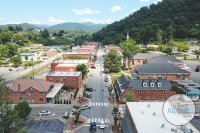Swain officials want more face time with park superintendent
 Swain County officials are hoping new leadership in the Great Smoky Mountains National Park means the start of a new relationship — one that will include better communication between the park and the county that is a gateway community.
Swain County officials are hoping new leadership in the Great Smoky Mountains National Park means the start of a new relationship — one that will include better communication between the park and the county that is a gateway community.
While 40 percent of the park’s half million acres are located in Swain County, officials often feel like the neglected side of the park as the administrative offices are located in Gatlinburg.
The Great Smoky Mountains National Park’s new superintendent, Cassius Cash, started Feb. 9 and held an informal meet and greet in Bryson City in March, but commissioners and tourism development staff are looking forward to more visits to work through some issues they’ve been dealing with for a number of years.
Tunnel graffiti
Some may see it as artwork, but others see it as a hindrance when trying to promote tourism in Swain County.
Karen Wilmot, executive director of the Swain County Tourism Development Authority, told the board recently that she had been trying to schedule a sit-down with Cash to discuss the graffiti problem in the North Shore Road tunnel, but didn’t get much response. She was told he would be visiting Bryson City in June to meet with several groups and would tour the tunnel at that time.
Related Items
Drivers can travel out of Bryson City on the Road to Nowhere but it ends just before the tunnel and then people must travel on foot through the long, dark tunnel to get to the hiking trails. The road and the tunnel are popular tourism attractions for the county but the tunnel has become a canvas for spray paint artists.
When dealing with travel writers, Wilmot said they are always fascinated with the Road to Nowhere as a writing topic. However, she is hesitant to publicize the attraction because the tunnel walls are filled with graffiti — some of which contains vulgar language and depictions.
“I just hate to pitch something with filthy language all over the walls,” she told the board.
Since the tunnel is on park property, it is the park’s responsibility to clean it up. The park has painted over the graffiti in the past, but Wilmot said it was in vain. She said there is an anti-graffiti paint available that could be used. If the walls were covered in the special paint, the graffiti could be washed off on a regular basis.
“Maybe if we become a park concessionaire we could do it ourselves,” she suggested.
Dana Soehn, a spokesperson for GSMNP, said the park was aware of the graffiti issues in the tunnel and staff does its best to paint over the most vulgar language and pictures on the walls.
“Unfortunately, it is difficult for our staff to react each time the tunnel is vandalized,” she said. “Repeatedly painting over the graffiti is costly and seems to only provide a fresh canvas for vandals.”
Soehn said the park is looking to work with the local community to find a better solution to the problem — preferably a cost-effective and sustainable solution.
“We hope that through education and increased vigilance, we can help reduce this problem,” she said.
Woody debris in the creeks
Swain County commissioners agreed last month to send a resolution to Cash asking the park to address the woody debris that ends up in the creeks when the park cuts down hazardous trees.
Commissioner David Monteith said the board has sent letters in the past but hasn’t received any response from the park. With a new superintendent in place, he said it would be a good idea to make Cash aware of the problem.
Monteith showed the board recent pictures of trees piling up along the banks of Deep Creek and Smokemont. When the water levels rise, he said those trees end up floating down the creek. His concern is that the woody debris could clog up the creek and increase the chance of flooding when there are heavy rains.
Commissioner Ben Bushyhead said a letter wasn’t strong enough to get something done.
“I think a resolution would show we’re more serious about it,” he said. “A letter is more polite than a resolution.”
The board agreed to draft a resolution to send and also try to set up a joint meeting with the superintendent.
“I’d love to get him down here and drive him around and show him the issues,” Monteith said.
Annually, the park removes hazard trees throughout the park to help make the 380-plus miles of roads, campgrounds and picnic areas safer for visitors. Last year, Soehn said the park contracted hazard tree removal in four areas of the park, including Newfound Gap Road between Smokemont and the Oconaluftee Visitor Center and Chimney’s Picnic Area to Alum Cave Trailhead, Elkmont Campground, Cades Cove Campground and Cades Cove Loop Road. In this same contract, trees in vistas along Lakeview Drive were removed to improve the scenic viewing opportunities along the drive for visitors.
In the section along Newfound Gap Road between Smokemont and the Oconaluftee Visitor Center, about 600 hazard trees along both sides of the road were removed. Of those, Soehn said no more than 25 trees were dropped in and near the river due to the direction the trees were leaning.
“After trees are cut, we don’t remove the trees due to the damage that would be caused by pulling and skidding them through natural areas which causes soil and vegetation disturbance.” she said.
Soehn said there are a multitude of other reasons why the trees don’t need to be removed from the waters and also a few perks that come with leaving them in the water. She said many state agencies purposely fall trees next to and into their waterways to create fish and shoreline habitat, improve soils, increase insect abundance and provide enhanced fishing opportunities.
“The waters of the Great Smoky Mountains National Park are clear, cold and pristine. However, they are very unproductive in terms of supporting fish and invertebrates,” she said. “Trees that fall into the river provide opportunities for insects to colonize, create fish habitat and help increase the productivity of the stream by putting tree biomass back into the water.”
Soehn said the park understands the concerns about the trees clogging the waterways and creating a flooding risk, which is why contractors are told to cut the trees into smaller lengths to help with the water flow.
As for the pictures Monteith showed of trees in Deep Creek and Smokemont, Soehn said they appear to have fallen from natural causes because it looks like they’ve been in the water for some time and don’t have cut marks.
“Log snags such as indicated in the photos occur naturally throughout the park and do not seem abnormal in a natural environment,” she said. “Again, Superintendent Cash and Deputy Superintendent Jordan do plan to visit these areas and look at them more carefully with staff to better understand all concerns.”









